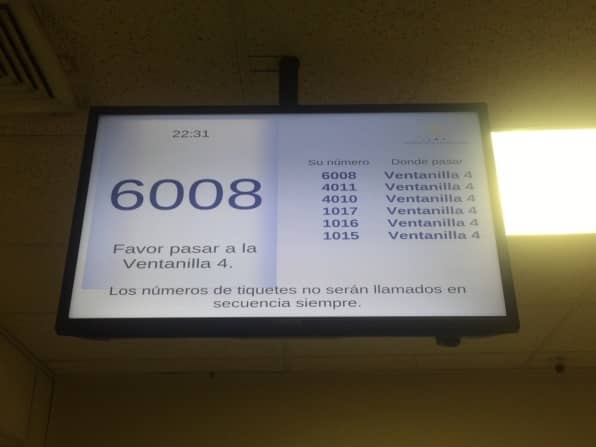
The $4.1 trillion United States Federal Budget for this fiscal year includes $54 billion in cuts to federal agency spending, including a 13% cut in discretionary funding for the Department of Transportation. It’s going to impact customer service at over-burdened organizations such as the DMV and TSA, that don’t have enough resources to handle their workload right now.
But it’s not really necessary that more government spending cuts mean that the customer experience has to suffer even more, with longer wait times for ordinary people, and hassled government employees doing more than their share of work.
There are simple solutions and technologies to reduce government spending without more spending, while nicely balancing the customer experience.
1. Go omnichannel to reduce wait times at government offices.
According to study results published on DMV.org, the average wait time for someone waiting to get a license is 44 minutes, while the wait time for any given state is 34 minutes.
The wait time for government services can be drastically reduced at the DMV and other federal, state and local government offices. All it needs is an omnichannel system that allows you to schedule appointments from anywhere, by simply requesting an SMS ticket online or by phone. This SMS ticket gives you a number and tells you when you have to come in. Arrive for your scheduled appointment at the right time, and you can get served immediately, and leave without having to wait in the branch with other people.
This means fewer crowds waiting in branches, which in means the agency doesn’t need that much space and is able to reduce government spending for maintaining large offices and lots of staff for handling crowds. A small office that can seat 5-10 customers at a time can replace an entire floor with a large hall filled with rows of seating space.
In Colorado, the ‘Wait Less’ program has reduced long lines of people down to below an hour. In Virginia, the DMV used a simulation program to come up with a more effective staffing model that would reduce average customer wait times down to below 20 minutes.
2. GSA energy savings performance contracts
The General Services Administration manages $500 billion worth of U.S. government property, including about 8,300 buildings (both owned and leased by the federal government) and a motor vehicle pool of over 210,000 vehicles. Some of the largest of these government properties are located in Washington, D.C., Virginia, Maryland and parts thereabout, where they cause massive bottlenecks as people flow in and out.
What the GSA is doing now is coming up plans to relocate or rebuild these giant complexes into modern environment-friendly office space that facilitates better customer service and the smooth flow of employees and customers through the buildings and the area.
For example, GSA had come up with consolidation plans to relocate the entire FBI headquarters from the J. Edgar Hoover Building in Washington, D.C. to one of three sites in Fairfax County, Virginia and Prince George’s County, Maryland. The plan was for the developer to build a new complex on one of these sites, and in exchange get the existing site in DC for redevelopment. The government gets a modern new office complex with little investment, and citizens and employees coming to the FBI building will get faster and much more efficient service and a better customer experience.
This plan has been put on hold because of budget funding cuts, which just highlights the importance of self-funded initiatives such as GSA’s Deep Retrofit Challenge that will use Energy Savings Performance Contracts (ESPCs) for energy efficiency retrofit projects, where energy savings pay for the investments made by private companies that complete these projects. These ESPCs are generating millions of dollars in energy savings for tax-payers through projects implemented at no new net costs for the taxpayer.
More information: energy.gov
3. BDP – NOAA’s Big Data Project
The economic value of large amounts of data collected by government agencies is often left untapped because they’re public sector organizations with a very clearly defined set of roles and activities. To make better use of this goldmine of big data, the weather data collected by NOAA is being made accessible on the public cloud. Anyone can use these data sets to power startups and services that access the numbers, crunch the data, and provide market intelligence to their customers.
This project and the atmospheric and ocean data that is available to the private sector is fueling innovation everywhere, from weather startups to the FAA, Maersk, Unilever, The Coca Cola Co., and the largest private cloud services providers such as Amazon and Microsoft. It also reduces government spending because BDP collaborators take up the responsibility of providing access to the data, it’s also helping reduce government infrastructure costs by reducing the load on NOAA systems.
4. SIB – DC Water’s Environmental Impact Bond
Social impact bonds have been around for a long time, but many of these projects were pilots being tested by local and state governments trying to decide if it was a weapon worth adding to their social policy agenda. Now there are some SIBs, such as DC Water’s EIB, that are actually turning out to be good models to follow by other utilities. This EIB is a 30-year tax-exempt municipal bond to fund a project to reduce stormwater runoff, issued with a $25 million face value.
At the 5-year threshold, there is a $3.3 million payment either to DC Water or to the investors, depending on the success or failure of the project. If the stormwater runoff reduction is more than 41.3% of the baseline impact of the project, then DC Water makes an additional ‘Outcome’ payment of $3.3 million to investors. If it’s less than 18.6%, then the investors make a risk-share payment to DC Water. If it’s between 18.6 and 41.3%, then there are no additional payments other than basic principal and interest.
More information: epa.gov